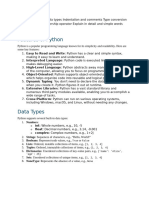0 ratings0% found this document useful (0 votes)
24 viewsUNIT II - Deep Dive Into Python
Python basics and it's functions
Uploaded by
shubhamjamghare77Copyright
© © All Rights Reserved
We take content rights seriously. If you suspect this is your content, claim it here.
Available Formats
Download as PDF, TXT or read online on Scribd
0 ratings0% found this document useful (0 votes)
24 viewsUNIT II - Deep Dive Into Python
Python basics and it's functions
Uploaded by
shubhamjamghare77Copyright
© © All Rights Reserved
We take content rights seriously. If you suspect this is your content, claim it here.
Available Formats
Download as PDF, TXT or read online on Scribd
You are on page 1/ 17
UNIT II
Deep Dive into Python
Boolean
❖ Boolean values are the two constant objects False and True.
❖ They are used to represent truth values (other values can also be considered
false or true).
❖ A string in Python can be tested for truth value.
❖ my_string = "Hello World"
❖ my_string.isalnum() #check if all char are numbers
❖ my_string.isalpha() #check if all char in the string are alphabetic
❖ my_string.isdigit() #test if string contains digits
List
❖ Lists are exible as:
❖ They have no xed size (meaning we do not have to specify how big a list will be).
❖ They have no xed type constraint.
❖ Some of the basic list methods used in python are:
❖ append
❖ pop
❖ sort
❖ reverse
fl
fi
fi
Nested List
❖ A great feature of Python data structures is that they support nesting.
List comprehensions
❖ List comprehensions provide a concise way to create lists.
❖ It consists of brackets containing an expression followed by a ‘for’ clause, then zero or
more ‘for’ or ‘if’ clauses.
❖ The basic syntax is:
❖ [expression for item in list if conditional]
❖ This is equivalent to:
❖ for item in list:
❖ if conditional:
❖ expression
Dictionaries
❖ A dictionary is a collection that is unordered, changeable, and indexed.
❖ In Python, dictionaries are written with curly brackets, and they have keys
and values. A dictionary can be constructed in the following manner:
Dictionaries
❖ We can also create keys by assignment.
❖ For instance, if we started off with an empty dictionary, we could continually add to it:
Dictionaries
❖ A few dictionary methods include:
❖ d.keys()
❖ d.values()
❖ d.items()
Tuples
❖ Tuples are very similar to lists. However, unlike lists, they are immutable, meaning they
cannot be changed.
❖ You would use tuples to present things that should not be changed, such as days of the
week, or dates on a calendar.
❖ The construction of a ‘tuples’ uses () with elements separated by commas.
Tuples
❖ Example of tuple unpacking:
❖ During the ‘for’ loop, we will be unpacking the tuple inside of a sequence and we can
access the individual items inside that tuple.
Python Fundamentals: Conditional Statements
Introduction to the IF statement
Python Fundamentals: Conditional Statements
Add an ELSE statement
Python Fundamentals: Conditional Statements
Else if, for Brief - ELIF
Python Fundamentals: While Loop
❖ Syntax:
❖ while test:
❖ code statements
❖ else:
❖ nal code statements
fi
break, continue, and pass statements
❖ We can use ‘break’, ‘continue’, and ‘pass’
statements in our loops to add additional
functionality for various cases. The three
statements are de ned as:
❖ break: Breaks out of the current closest
enclosing loop
❖ continue: Goes to the top of the closest
enclosing loop
❖ pass: Does nothing at all
fi
Python Fundamentals: Functions
De ning a Function in Python
fi
Python Fundamentals: Functions
Creating a Function with a Parameter
You might also like
- Discrete Structures Lab 1 Python Basics: 1 Python Installation 2 Python TutorialNo ratings yetDiscrete Structures Lab 1 Python Basics: 1 Python Installation 2 Python Tutorial8 pages
- Introduction To Python: Irandufa IndebuNo ratings yetIntroduction To Python: Irandufa Indebu87 pages
- Mooc Seminar: Name Rajat Kushwaha St. Id 200211241 Section I'No ratings yetMooc Seminar: Name Rajat Kushwaha St. Id 200211241 Section I'46 pages
- Sequence_mapping_branching self made notesNo ratings yetSequence_mapping_branching self made notes9 pages
- 2 & 3 - Python Conditions, Loops, FunctionsNo ratings yet2 & 3 - Python Conditions, Loops, Functions43 pages
- Columbiax - BAMM 101 - Python For AnalyticsNo ratings yetColumbiax - BAMM 101 - Python For Analytics38 pages
- An Introduction To Python Programming LanguageNo ratings yetAn Introduction To Python Programming Language63 pages
- Python 101: Understanding The Nuts and Bolts of PythonNo ratings yetPython 101: Understanding The Nuts and Bolts of Python46 pages
- PYTHON DATA SCIENCE FOR BEGINNERS: Unlock the Power of Data Science with Python and Start Your Journey as a Beginner (2023 Crash Course)From EverandPYTHON DATA SCIENCE FOR BEGINNERS: Unlock the Power of Data Science with Python and Start Your Journey as a Beginner (2023 Crash Course)No ratings yet
- Python programming for beginners: Python programming for beginners by Tanjimul Islam TareqFrom EverandPython programming for beginners: Python programming for beginners by Tanjimul Islam TareqNo ratings yet
- Revised Competency, Electrical & Computer Engineering at JJUNo ratings yetRevised Competency, Electrical & Computer Engineering at JJU13 pages
- Workstation Player 15 Windows User GuideNo ratings yetWorkstation Player 15 Windows User Guide154 pages
- Tuv India Training Academy Online Training Programs: Click Here For Android For IosNo ratings yetTuv India Training Academy Online Training Programs: Click Here For Android For Ios10 pages
- SAP Customer Interaction Center - Account IdentificationNo ratings yetSAP Customer Interaction Center - Account Identification1 page
- Skills Training Eligibility Inter June 2022 TermNo ratings yetSkills Training Eligibility Inter June 2022 Term1 page
- Download Full The Rough Guide to Nepal 10th Edition Stuart Butler PDF All Chapters100% (3)Download Full The Rough Guide to Nepal 10th Edition Stuart Butler PDF All Chapters28 pages
- Synopsis "Cyber Café Management System": Class: Xi-Computer Science Section: ENo ratings yetSynopsis "Cyber Café Management System": Class: Xi-Computer Science Section: E8 pages

























































































